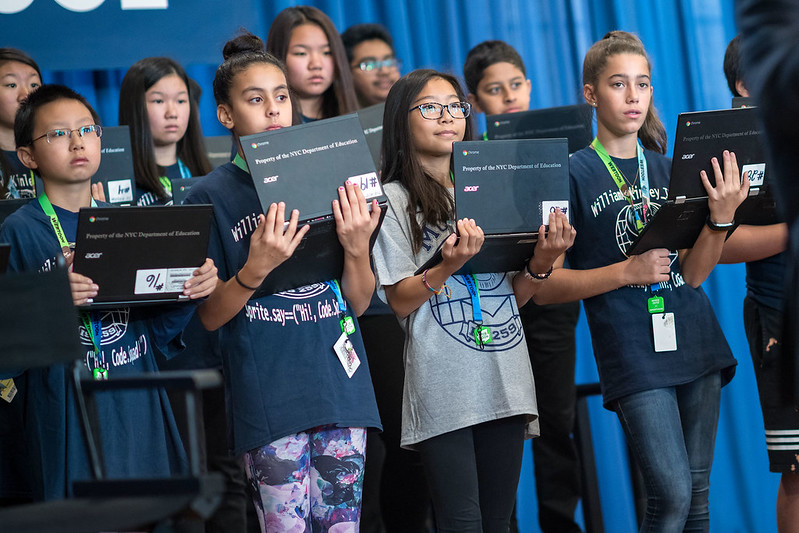
Students and laptops, eyeing the digital divide (photo: Ed Reed/Mayoral Photography Office)
Among the many lessons the coronavirus outbreak is teaching us about our society is that we are not prepared to live in the 21st century, particularly residents in low-income communities with little or no access to much-needed technology.
This century is a time of continued uncertainty, in which established norms change overnight and disruptions are being regularly caused by natural and man-made disasters. Our largely interconnected globe means that the spread of information, goods, and diseases can occur with lightning speed.
We’re in the midst of another technological revolution that is dramatically changing how people shop, communicate, work, and learn.
But even before the coronavirus pandemic, not everyone had been part of the changes that have been occurring in the 21st Century. And those discrepancies have come into full relief, and been exacerbated, as COVID-19 has led to school and workplace closures.
Consider the implications of the “stay at home” orders requiring K-12 schools, colleges, and universities to move education from in-person to remote, online learning.
Many educators are ill-prepared to teach online; many students are unable to connect for their online classes. In New York City, a million households lack access to the Internet and, if they have a connection, it is often at speeds too slow for effective online education. Nearly 300,000 students in the New York City public schools have no computer or tablet of their own to access the Internet. In an age where companies have enormous amounts of data on individuals, the New York City Department of Education had no idea which students have access to the Internet or own a computer or tablet -- the city is now promising all who need them will have them seven weeks after school buildings were closed due to the pandemic. How can the DOE plan for a crisis without this kind of imperative data? The same can be said about the challenges faced by public colleges and universities.
The Center for an Urban Future recently reported the tech sector in New York City has been expanding faster than the number of available skilled personnel to fill the jobs. To qualify for these high-paying jobs requires education and the development of special skills – such as critical thinking, complex problem solving, teamwork, and the ability to work under uncertain conditions. The report further identified the underrepresentation of youth from low-income communities in the tech sector. The move to online education, however long it may last, reinforces the gaps for low-income communities, and shines a bright spotlight on the fact that students’ lack of access to the Internet and the equipment needed to access it are key reasons why these same young people can’t acquire the skills and knowledge needed for the 21st Century economy.
For all practical purposes, we have a system accessible only to those who can pay for access. In the 21st century, everyone needs access to a computer or tablet and connectivity to the Internet to make their way in life. For most, the only option is paying a private provider – this is not a viable option for many low-income families.
It is time to stop thinking of the Internet as a private good available only to those who can pay. Instead, the Internet needs to be viewed as a public good accessible to all, independent of ability to pay. As a public good access to the internet has to be extended to all households, independent of their ability to pay. Efforts in New York to accomplish this through charter agreements with cable companies have proven ineffective. The enormous federal funding allocated to address the many issues raised by the coronavirus pandemic provides opportunity for achieving an essential goal: completing the nation’s “Information Highway,” or Internet network. Speaker Nancy Pelosi has indicated the House of Representatives is considering such an effort in a new infrastructure bill. Once the internet is available throughout the U.S., providers need to develop service plans that provide low-income communities, whether urban or rural, access to basic services at an affordable cost.
Life is not going to return to the way it was before the coronavirus. More people will work, learn, shop, and play using varied online tools, and more remotely than ever.
Bringing all Americans into the information age will require a momentous effort on the scale of the federal project that brought electricity to darkened regions of the country during the New Deal. The coronavirus has made it clear that completing the Information Highway, making it accessible to all, independent of ability to pay, is critical to the national interest and addressing the social injustice caused by the digital divide.
***
Stan Altman is President, Science and Arts Engagement New York, Inc; Professor, Marxe School of Public and International Affairs, Baruch College; and Visiting Professor, The City College of New York.
***
Have an op-ed idea or submission for Gotham Gazette? Email This email address is being protected from spambots. You need JavaScript enabled to view it.